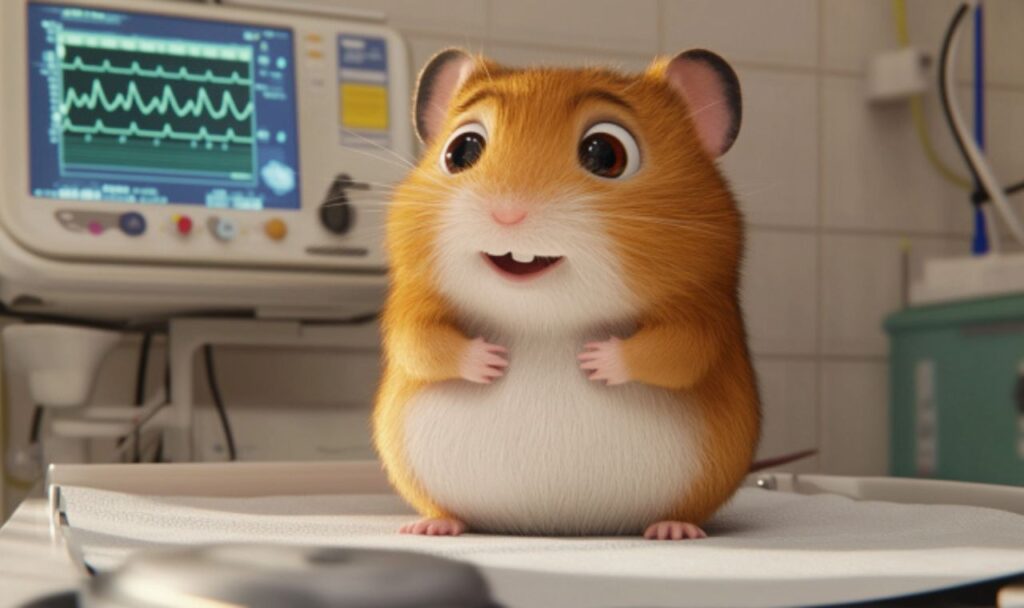Hamsters may be small, but they have big personalities—and their health is just as important as any other pet’s. However, unlike dogs or cats, hamsters are experts at hiding signs of illness. This natural instinct, while useful in the wild to avoid predators, can make it challenging for us hamster parents to notice when something is wrong. Recognizing subtle changes in your hamster’s behavior, appearance, or habits is essential for early detection and treatment of health issues. In this section, I’ll explain why hamsters mask their symptoms, what happens if you miss the early warning signs, and how this article will help you become more attuned to your furry friend’s health.
Hamsters Hide Their Illness
Hamsters are prey animals by nature, which means they’ve developed certain survival instincts to avoid becoming an easy target in the wild. One of these instincts is to mask signs of weakness or illness. In the wild, a sick hamster might be singled out by predators, so staying as “normal” as possible is their best defense. Unfortunately, this instinct carries over to your pet hamster, even in the safety of their cozy cage at home.
This natural tendency to hide illness makes it tricky to spot when something is wrong. You might think your hamster looks and acts fine, only to discover later that they’ve been quietly battling a health issue for days or even weeks. That’s why it’s important to pay close attention to the smaller, subtler signs that something might not be right.
The Risks of Missing Subtle Signs
When it comes to hamster health, time is of the essence. Due to their small size and fast metabolism, illnesses can progress rapidly in hamsters. What starts as a minor issue, such as a decrease in appetite, can escalate into a more serious condition like malnutrition or dehydration if left unchecked. Similarly, a respiratory issue might begin with subtle wheezing and quickly develop into a life-threatening infection if not treated promptly.
Missing the early signs of illness can lead to more complex health problems that are harder—and sometimes impossible—to treat. Early detection gives you the best chance to address the problem before it becomes severe. That’s why learning to recognize subtle symptoms isn’t just helpful; it could save your hamster’s life.
What You’ll Learn in This Article
This article is your guide to spotting the silent signs of illness in hamsters. I’ll cover:
- Behavioral Changes: What to watch for if your hamster seems less active, isn’t eating normally, or starts behaving oddly.
- Physical Symptoms: Subtle but telling signs like weight changes, fur loss, or unusual discharges that might indicate a health issue.
- Hard-to-Notice Clues: Symptoms like changes in posture, breathing patterns, or sleep habits that can be easy to overlook.
By the end of this article, you’ll have the tools and knowledge to monitor your hamster more effectively and catch potential health issues early. If something feels off, I’ll also guide you on when and how to seek veterinary care, so you can act quickly to protect your little buddy.
Being proactive and informed is the best way to keep your hamster healthy and happy. Let’s dive into the signs to watch for!
Behavioral Changes That Signal Illness

Hamsters are creatures of habit, and their behavior is one of the best indicators of their overall health. When your typically energetic and curious hamster starts acting differently, it could be their way of signaling that something isn’t right. Subtle changes in activity levels, eating or drinking habits, or temperament can all point to underlying health problems. By staying tuned in to these behavioral shifts, you’ll be better equipped to catch illnesses early and provide the care your hamster needs.
Decreased Activity Levels
Hamsters are known for their bursts of energy, especially at night when they run on their wheel, burrow through bedding, or explore their cage. If your normally active hamster suddenly seems lethargic, sleeps more than usual, or stops engaging with their environment, it’s a red flag that something may be wrong.
Possible causes of decreased activity include:
- Illness or Pain: Conditions like respiratory infections, gastrointestinal issues, or joint problems can sap your hamster’s energy.
- Nutritional Deficiencies: A lack of essential nutrients in their diet can lead to fatigue and sluggishness.
- Temperature Sensitivity: Hamsters are sensitive to extreme temperatures. If it’s too cold or too hot, they may become less active.
What to do: Start by observing your hamster’s behavior closely over 24–48 hours. If the inactivity continues or is paired with other symptoms like loss of appetite, labored breathing, or a hunched posture, it’s time to contact a vet.
Changes in Eating or Drinking Habits
Hamsters are creatures of routine when it comes to their eating and drinking. If you notice changes in how much your hamster eats or drinks, it could signal a health issue.
- Reduced Appetite: A hamster that’s not eating as much as usual or ignoring their favorite treats might be experiencing dental problems, gastrointestinal discomfort, or an underlying illness.
- Increased Water Consumption: Drinking more water than usual can indicate dehydration, kidney problems, or even diabetes (a condition that’s more common in certain species, like Campbell’s dwarf hamsters).
- Food Hoarding Without Eating: Hamsters naturally hoard food, but if they’re stashing more than they’re consuming, it could be a sign they’re unwell or experiencing dental pain.
What to do: Monitor their food and water intake daily. Weigh your hamster regularly to check for any unexpected weight loss. If eating or drinking habits don’t return to normal after a day or two, or if you notice other symptoms, consult your veterinarian promptly.
Unusual Aggression or Fearfulness
Hamsters are generally gentle creatures, but pain or discomfort can cause sudden changes in their temperament. If your typically calm hamster becomes aggressive, starts biting, or seems more fearful than usual, it may be their way of communicating distress.
Here are some potential reasons for behavioral shifts:
- Pain or Illness: A hamster in pain from an injury, dental issue, or internal condition may lash out when touched.
- Stress or Fear: Environmental stressors, such as loud noises, a dirty cage, or too much handling, can exacerbate their discomfort.
- Neurological Issues: In rare cases, aggression or fearfulness may be linked to neurological problems or illnesses affecting their brain.
What to do: First, check for obvious causes of stress, such as an overcrowded cage, bright lights, or noisy surroundings. Next, observe whether their aggression happens only when touched, which could indicate pain. If the behavior persists, a vet visit is essential to rule out underlying health issues.
Physical Signs of Poor Health

Your hamster’s body can reveal a lot about their health if you know what to look for. Subtle physical changes like unexpected weight fluctuations, problems with their fur and skin, or unusual discharges from the eyes, nose, or ears can all signal underlying health issues. Since hamsters are experts at hiding illness, spotting these physical symptoms early gives you a better chance to address problems before they become serious. Let’s take a closer look at these key signs and what they could mean.
Weight Loss or Gain
Hamsters typically maintain a consistent weight once they reach adulthood, so any noticeable change—whether it’s a loss or a gain—should catch your attention.
- Weight Loss: Sudden or gradual weight loss can be a sign of:
- Dental Problems: Overgrown teeth or infections can make eating painful.
- Internal Illness: Conditions like gastrointestinal issues, tumors, or organ problems can cause your hamster to lose weight.
- Stress: Environmental factors like cage overcrowding, loud noises, or frequent handling can lead to reduced appetite and weight loss.
- Weight Gain: While slightly chubby hamsters might seem cute, significant weight gain can indicate:
- Overfeeding: Too many treats or calorie-dense foods like sunflower seeds or nuts can lead to obesity.
- Fluid Retention: Swelling caused by fluid retention could point to serious conditions like heart disease or kidney problems.
- Pregnancy: If you have a female hamster who’s been in contact with a male, sudden weight gain could mean she’s pregnant.
What to do: Weigh your hamster weekly using a small kitchen scale to track changes. A healthy adult Syrian hamster should weigh between 100–150 grams, while dwarf hamsters typically weigh between 25–50 grams. If you notice a consistent change in weight, consult your veterinarian to determine the cause.
Fur and Skin Changes
Your hamster’s fur and skin are excellent indicators of their health. A healthy hamster will have a soft, shiny coat and clear, healthy skin. Changes in their fur or skin condition, however, may signal underlying problems.
- Hair Loss: Bald patches can result from:
- Mites or Parasites: These tiny pests can irritate the skin and lead to scratching and fur loss.
- Allergies: Bedding materials or food could be triggering an allergic reaction.
- Hormonal Imbalances: Older hamsters, in particular, may experience fur thinning due to hormonal changes.
- Dandruff or Flaky Skin: This may be caused by:
- Dry Air: In winter months, low humidity can cause your hamster’s skin to dry out.
- Poor Diet: A lack of essential nutrients, particularly omega-3 fatty acids, can lead to dry, flaky skin.
- Sores or Scabs: Open wounds or scabs might result from:
- Injuries: Sharp cage accessories or fights with other hamsters.
- Infections: Bacterial or fungal infections that require veterinary treatment.
What to do: Inspect your hamster’s fur and skin regularly, especially if they’re scratching more than usual. Keep their cage clean and free of irritants, and ensure their diet is balanced with plenty of fresh vegetables and hamster-safe seeds. If fur loss or skin issues persist, schedule a vet visit to identify and treat the cause.
Eye, Nose, or Ear Discharge
Discharges from your hamster’s eyes, nose, or ears are abnormal and often indicate an infection or underlying illness.
- Eye Discharge: Watery, crusty, or swollen eyes could be signs of:
- Conjunctivitis: Also known as pink eye, this can be caused by bacterial infections, irritants like dust, or dirty bedding.
- Eye Injuries: Accidents involving sharp objects or fighting with cage mates can result in eye irritation or discharge.
- Nose Discharge: A runny or crusty nose may point to:
- Respiratory Infections: Symptoms often include sneezing, wheezing, or labored breathing.
- Allergies: Dusty bedding or strong odors in the room may irritate your hamster’s nose.
- Ear Discharge: Any fluid or wax buildup in the ears could indicate:
- Ear Infections: Often accompanied by head tilting or balance issues.
- Mite Infestations: Mites can cause irritation and excess ear wax production.
What to do: If you notice discharge from your hamster’s eyes, nose, or ears, clean the area gently with a damp cotton ball. However, this is not a cure—discharge is a sign of an underlying problem that requires professional attention. Take your hamster to a vet as soon as possible to diagnose and treat the issue.
Subtle Symptoms You Might Overlook

When it comes to hamster health, not all symptoms are obvious. Some signs of illness can be so subtle that they’re easy to miss—until the problem becomes severe. Breathing changes, posture shifts, and unusual sleeping habits might not seem alarming at first, but they can be important indicators of underlying health issues. In this section, I’ll guide you through these often-overlooked symptoms and explain what they could mean for your hamster’s well-being.
Changes in Breathing Patterns
A healthy hamster should breathe quietly and steadily, with no visible effort. If you notice labored, wheezy, or noisy breathing, it could signal a respiratory issue that needs immediate attention.
- Labored Breathing: If your hamster appears to be breathing heavily or with difficulty, it could be due to:
- Respiratory Infections: These are common in hamsters and can be caused by bacteria, viruses, or drafts from cold air.
- Allergic Reactions: Dusty bedding, scented products, or environmental irritants may trigger breathing problems.
- Pneumonia: A more severe respiratory infection that often starts with mild symptoms like sneezing or wheezing.
- Wheezing or Clicking Sounds: Any unusual noises when your hamster breathes could indicate:
- Bronchitis: An infection or inflammation of the airways that can lead to noisy breathing.
- Asthma or Allergies: While less common, hamsters can suffer from asthma-like symptoms due to irritants in their environment.
- Nasal Flare or Open-Mouth Breathing: If your hamster is flaring their nostrils or breathing through their mouth, this is a sign of severe distress and should be treated as an emergency.
What to do: Check your hamster’s environment for potential irritants like dust or drafts, and ensure their cage is in a warm, ventilated, but not drafty area. If breathing problems persist or worsen, take your hamster to a vet immediately. Respiratory issues can progress quickly in hamsters, so prompt care is essential.
Posture and Movement Abnormalities
A hamster’s posture and the way they move can provide important clues about their health. While hamsters are naturally curious and agile, certain changes in how they carry themselves might indicate pain, injury, or illness.
- Hunched Posture: A hamster that sits or walks with a hunched back may be experiencing:
- Pain or Discomfort: This could be due to digestive issues, such as constipation or bloating, or more serious internal problems.
- Infections: A hunched posture is a common symptom of wet tail, a bacterial infection that requires urgent veterinary care.
- Limping or Stiff Movements: Difficulty moving, climbing, or limping on one leg can point to:
- Injuries: Sprains, fractures, or cuts from falls or rough surfaces in the cage.
- Arthritis: Older hamsters may develop arthritis, which makes movement painful.
- Difficulty Climbing or Balancing: A hamster that struggles to climb or loses balance may be suffering from:
- Neurological Issues: Problems with the brain or inner ear can affect balance and coordination.
- Weakness or Fatigue: Illness or malnutrition can sap a hamster’s strength, making normal activities harder.
What to do: Observe your hamster during their active hours to assess their movements. Remove any sharp or high surfaces in their cage to prevent further injuries. If the posture or movement issues persist, consult a vet to identify and treat the underlying cause.
Unusual Sleeping Habits
Hamsters are nocturnal by nature, which means they’re most active during the night and tend to sleep during the day. However, changes in their sleeping patterns or positions can sometimes indicate a problem.
- Excessive Sleeping: While hamsters do sleep a lot, if your hamster seems to be sleeping far more than usual or is difficult to wake up, it could be due to:
- Illness: Conditions like respiratory infections or malnutrition can make your hamster lethargic.
- Hypothermia: If their cage is too cold, hamsters may enter a state of torpor, which looks like deep sleep but is actually a survival mechanism.
- Odd Sleeping Positions: Hamsters usually sleep curled up in their nest, so if they’re sleeping in unusual positions (e.g., stretched out flat or hunched), it could indicate:
- Pain or Discomfort: Your hamster might be trying to find a position that eases pain.
- Respiratory Issues: Stretching out flat may help them breathe more easily if they’re struggling.
- Sleeping Outside Their Nest: If your hamster suddenly avoids their usual sleeping area, it could mean:
- Environmental Stress: Dirty bedding, cage overcrowding, or loud noises might make their nest uncomfortable.
- Fever or Discomfort: They may be seeking a cooler or warmer spot due to illness.
What to do: Keep an eye on your hamster’s sleeping habits and check their cage conditions. Ensure their nest is clean, cozy, and free of irritants. If excessive sleeping or unusual positions persist, it’s time to visit the vet.
When and How to Seek Veterinary Care

No matter how well we care for our hamsters, there may come a time when their health requires professional attention. Knowing when and how to seek veterinary care is crucial to ensuring your hamster gets the treatment they need in time. Hamsters are small, delicate creatures, and even minor symptoms can quickly become life-threatening without prompt intervention. In this section, I’ll cover when you should act immediately, how to find a vet who specializes in small animals, and how to prepare for the vet visit to make the experience as stress-free as possible for both you and your furry friend.
When to Act Immediately
Some symptoms in hamsters are clear signs of a serious problem and require immediate veterinary care. Because of their small size and fast metabolism, hamsters can deteriorate quickly if these warning signs are ignored. Here are symptoms that should never wait:
- Bleeding: Whether from an injury, an internal issue, or excessive bleeding from the nose, mouth, or anus, bleeding is always an emergency.
- Seizures or Sudden Collapse: Seizures, trembling, or sudden loss of coordination could indicate neurological issues, poisoning, or severe illness.
- Labored or Open-Mouth Breathing: If your hamster is struggling to breathe, flaring their nostrils, or breathing through their mouth, this is a critical emergency.
- Severe Lethargy or Unresponsiveness: A hamster that isn’t waking up or moving when touched is likely experiencing a serious health crisis, such as hypothermia or organ failure.
- Bloated Belly: A swollen or hard abdomen could signal gastrointestinal blockages, organ problems, or even wet tail—a life-threatening bacterial infection.
What to do: If you notice any of these symptoms, don’t wait. Call a veterinarian immediately, explain the situation, and let them know you’re on your way. Time is of the essence, and even a short delay can have serious consequences for your hamster.
Finding an Experienced Vet
Not all veterinarians are familiar with hamsters or other small animals. These tiny creatures have unique needs and anatomy, so it’s essential to find a vet with experience treating rodents. Here’s how to locate the right vet:
- Search for an Exotic Animal Specialist: Hamsters fall under the category of “exotic pets,” so look for a vet who explicitly mentions expertise with small animals, rodents, or exotics.
- Ask for Recommendations: Reach out to hamster groups, forums, or other pet owners in your area for vet recommendations. A personal referral can help you find someone trustworthy and knowledgeable.
- Check Online Reviews: Research local clinics and read reviews to see if they’ve successfully treated hamsters or other small pets.
- Call Ahead: Before an emergency happens, contact potential clinics and ask if they have experience treating hamsters. Some clinics may have a specialist on staff or be able to refer you to another trusted professional.
Keep the vet’s contact information readily available, so you don’t waste valuable time searching for help during an emergency.
Preparing for the Vet Visit
When the time comes to take your hamster to the vet, proper preparation can make all the difference. Hamsters are easily stressed by travel, so your goal is to minimize their discomfort while ensuring you provide the vet with all the necessary information.
Here’s how to prepare for the trip:
1. Transporting Your Hamster Safely
- Use a secure carrier designed for small animals. If you don’t have one, a plastic container with air holes and a secure lid can work in a pinch.
- Line the carrier with familiar bedding to make your hamster feel more comfortable. Add a small piece of their favorite hideout or some nesting material from their cage.
- Include a small amount of food and a slice of cucumber or apple to provide hydration during the trip, as water bottles may leak in transit.
- Avoid placing the carrier near loud noises, direct sunlight, or cold drafts during travel.
2. Bring Important Details
Your vet will need as much information as possible to diagnose your hamster, so come prepared:
- Describe the Symptoms: Write down when you first noticed the symptoms, how they’ve progressed, and any changes in behavior or diet.
- List Their Diet and Environment: Note what your hamster eats daily, including any new foods, treats, or supplements, and describe their cage setup.
- Mention Any Recent Changes: Include details about recent stressors, such as a move, a new pet in the house, or a change in bedding or food.
3. Stay Calm
Hamsters can sense your emotions, so staying calm and collected will help reduce their stress. Speak softly to your hamster during the journey and handle them gently when placing them in the carrier or at the vet’s office.
Hannah’s Care Tips: Monitoring and Preventing Illness

As much as we all want our hamsters to live long and healthy lives, preventing illness and catching early symptoms requires a little extra effort on our part. Monitoring your hamster’s health doesn’t have to be overwhelming—in fact, it can easily become part of your daily routine. With a few simple strategies like keeping a health journal, maintaining a clean environment, and setting aside time for observation, you can dramatically improve your hamster’s chances of staying happy and healthy. Let me show you how!
Keep a Hamster Health Journal
One of the most effective ways to monitor your hamster’s health over time is by keeping a health journal. This doesn’t need to be fancy—just a notebook or even a notes app on your phone will do. The idea is to log your hamster’s behaviors, eating habits, and weight regularly so you can spot trends or subtle changes that might indicate a problem.
Here’s what to include in your health journal:
- Daily Behavior: Note your hamster’s energy levels, activity patterns, and overall temperament. For example, “Ran on the wheel for 20 minutes” or “Seemed less active than usual.”
- Food and Water Intake: Record how much they’re eating and drinking. Watch for changes like a sudden lack of interest in food or an increase in water consumption.
- Weight: Weigh your hamster weekly using a small kitchen scale. Track their weight over time to detect gradual losses or gains, which can be an early sign of illness.
- Unusual Symptoms: Log any signs of concern, such as sneezing, changes in fur condition, or limping. Even if the symptom seems minor, it’s worth tracking to see if it improves or worsens.
Why it works: By reviewing your health journal, you’ll be able to spot patterns and act on small changes before they escalate into bigger problems. Plus, this information can be incredibly helpful to your vet if you ever need to seek professional advice.
Maintain a Clean Environment
A clean and safe environment is one of the most important factors in preventing illness. Hamsters are small and sensitive creatures, and poor cage hygiene or contaminated water can quickly lead to health problems like respiratory infections, wet tail, or parasites.
Here are some simple tips to keep your hamster’s environment healthy:
- Clean the Cage Regularly: Spot-clean daily by removing soiled bedding and leftover food. Do a full cage clean every 1–2 weeks, replacing all bedding and wiping down surfaces with a hamster-safe disinfectant.
- Choose the Right Bedding: Avoid dusty or scented bedding, as it can irritate your hamster’s respiratory system. Opt for paper-based or aspen bedding, which is safe and comfortable.
- Provide Fresh Water Daily: Refill your hamster’s water bottle with clean, fresh water every day. Check for leaks and make sure the nozzle is working properly. Stale or contaminated water can harbor bacteria that lead to illness.
- Sanitize Accessories: Clean food bowls, water bottles, and toys regularly to prevent the buildup of bacteria or mold.
Why it works: A clean, well-maintained cage reduces your hamster’s exposure to harmful bacteria, mold, and dust, keeping their immune system strong and illnesses at bay.
Establish a Routine for Observation
Hamsters are excellent at hiding signs of illness, so the best way to catch subtle symptoms early is to make daily observation part of your routine. Even dedicating just a few minutes a day to checking on your hamster can make a big difference.
Here’s how to set up a simple observation routine:
- Check During Active Hours: Hamsters are nocturnal, so the best time to observe them is during the evening or nighttime when they’re naturally awake. Look for signs of normal activity, like running on the wheel or foraging for food.
- Inspect Their Appearance: Quickly check their fur, eyes, nose, and ears for anything unusual, like discharge, bald patches, or swelling. Look at their teeth and nails if possible to make sure they’re the right length.
- Watch Their Movements: Observe how your hamster moves. Are they climbing and running normally? Or do you notice limping, stiffness, or a hunched posture?
- Listen to Their Breathing: While handling your hamster or observing them at rest, listen for any wheezing, clicking, or labored breathing, which could indicate respiratory problems.
- Engage Them Briefly: Offer a treat or a gentle touch to see how they respond. If your normally friendly hamster suddenly becomes aggressive, fearful, or uninterested, it could signal pain or discomfort.
Why it works: Consistent observation helps you learn what’s “normal” for your hamster, making it easier to recognize when something is off. It also strengthens the bond between you and your pet, as they’ll grow more comfortable with your attention over time.
Conclusion: Stay Alert to Protect Your Hamster

Hamsters may be small and quiet, but their health requires big attention. Recognizing the silent symptoms of illness early can make a world of difference in your hamster’s well-being and longevity. Because these tiny creatures are experts at hiding their vulnerabilities, it’s up to us as their caretakers to stay vigilant and notice the subtle changes that might signal a problem. By acting quickly, you can ensure that your hamster gets the help they need, giving them the best chance at a happy and healthy life.
Throughout this article, we’ve explored the behavioral, physical, and subtle symptoms that might indicate your hamster is unwell. From decreased activity levels to changes in posture, weight loss to unusual sleeping habits, these signs are your hamster’s way of communicating that something might be wrong. Catching these symptoms early, before they develop into more serious issues, is the key to keeping your hamster thriving.
Trust Your Instincts
No one knows your hamster better than you. If something about their behavior or appearance feels “off,” trust your instincts. Even if the change seems small or insignificant, it’s better to investigate and be safe than to overlook a potential problem. Your hamster depends on you to notice these changes—they can’t speak, but their actions, habits, and even their tiny squeaks are all ways of telling you how they feel.
Don’t hesitate to seek veterinary advice if something concerns you. Hamsters are delicate animals, and timely care can mean the difference between recovery and worsening illness. By trusting your gut and acting promptly, you’re not just being a responsible hamster parent—you’re potentially saving their life.
Provide the Best Life with Care and Attention
While illnesses can happen to even the most well-cared-for hamster, your love and attentiveness are their greatest protection. Keeping a health journal, maintaining a clean and enriching environment, and taking time each day to observe your hamster will give you a clear understanding of their normal habits. This foundation of care allows you to spot early warning signs and take action when needed.
Remember, hamster care is a learning process. Don’t be hard on yourself if you miss something—it happens to the best of us. What matters is your willingness to learn, grow, and give your hamster the best life possible. With your dedication, they’ll enjoy the love, comfort, and happiness every hamster deserves.
A Final Word
Hamsters may live quietly in their cages, but they bring so much joy and energy into our lives. By staying alert and proactive, you’re ensuring that your furry friend enjoys the healthiest, happiest life possible. Whether it’s through regular monitoring, a trip to the vet, or simply sharing quiet moments together, your care and attention mean everything to your hamster.
So take a deep breath, give your little buddy a treat (or an extra sunflower seed!), and remember that you’re doing an amazing job. With paws and patience, you’re on the road to being a Hamster Whisperer. Happy training!




